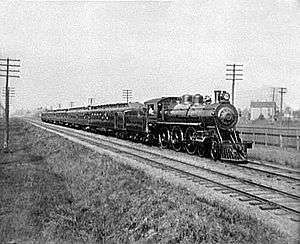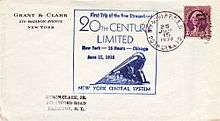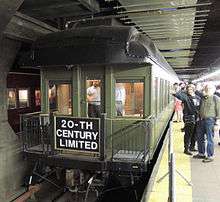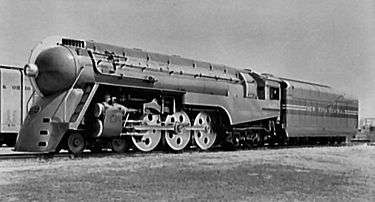20th Century Limited


The 20th Century Limited was an express passenger train on the New York Central Railroad (NYC) from 1902 to 1967, advertised as "The Most Famous Train in the World".[1] In the year of its last run, The New York Times said that it "...was known to railroad buffs for 65 years as the world's greatest train".[2] The train traveled between Grand Central Terminal (GCT) in New York City and LaSalle Street Station in Chicago, Illinois, along the railroad's "Water Level Route".
The NYC inaugurated this train as competition to the Pennsylvania Railroad, aimed at upper class and business travelers. It made few station stops along the way and used track pans to take water at speed. Beginning on June 15, 1938, when it got streamlined equipment, it ran the 958 miles in 16 hours, departing New York City at 6:00 P.M. Eastern Time and arriving at Chicago's LaSalle Street Station the following morning at 9:00 A.M. Central Time, averaging 60 miles per hour (97 km/h).[3] For a few years after World War II, the eastward schedule was shortened to 15½ hours.
Its style was described as "spectacularly understated ... suggesting exclusivity and sophistication".[4]:48–49 Passengers walked to the train on a crimson carpet which was rolled out in New York and Chicago and was designed for the 20th Century Limited. "Getting the red carpet treatment" passed into the language from this memorable practice.[5] "Transportation historians", said the writers of The Art of the Streamliner, "consistently rate the 1938 edition of the Century to be the world's ultimate passenger conveyance—at least on the ground".[4]:46
History

Inaugurated on June 17, 1902, by patent medicine salesman turned passenger agent George Henry Daniels, the train offered a barbershop and secretarial services.[6] The train arrived in Chicago three minutes ahead of schedule; the schedule was twenty hours, four hours less than before. The New York Times report laid great stress on the routine nature of the trip, with no special procedures being followed and no extra efforts being made to break records. It stated that there "...was no excitement along the way," and quoted a railroad official's claim "...it is a perfectly practical run and will be continued," and engineer William Gates maintaining "This schedule can be made without any difficulty. I can do it every time, barring accidents."[6]
The schedule dropped to 18 hours in June 1905, the same month that the train was wrecked (June 21, 1905) on the Lake Shore & Michigan Southern Railway line at Mentor, Ohio. It reverted to 20 hours in 1912 and was unchanged until 1932. In 1935 it dropped to 16 hours, 30 minutes, then to 16 hours on June 15, 1938, when lightweight cars took over.
Regular passengers included Theodore Roosevelt, William Jennings Bryan, Lillian Russell, "Diamond Jim" Brady, J. P. Morgan, Enrico Caruso, and Nellie Melba.
In the 1920s the New York-Chicago fare was $32.70 plus the extra fare of $9.60, plus the Pullman charge (e.g. $9 for a lower berth), for a total of $51.30. For that one got a bed closed off from the aisle by curtains; a compartment to oneself would cost more. In 1928, the peak year, the train earned revenue of $10 million and was believed to be the most profitable train in the world.[7]
Shortly after the announcement of the fluorescent lamp, the cars of the 20th Century Limited were lit with this new type of lamp.[8]


In 1938 industrial designer Henry Dreyfuss was commissioned by the New York Central to design streamlined train sets in Art Deco style, with the locomotive and passenger cars rendered in blues and grays (the colors of NYC). The streamlined sets were inaugurated on June 15, 1938. His design was probably the most famous American passenger train.[6] Like many express passenger trains through the mid-1960s, the 20th Century Limited carried an East Division (E.D.) Railway Post Office (R.P.O.) car operated by the Railway Mail Service (RMS) of the United States Post Office Department which was staffed by USPOD clerks as a "fast mail" on each of its daily runs.[9] The mails received by, postmarked, processed, sorted, and dispatched from the 20th Century Limited 's RPOs were either canceled or backstamped (as appropriate) during the trip by hand applied circular date stamps (CDS) reading "N.Y. & CHI. R.P.O. E.D. 20TH CEN.LTD." and the train's number: "25" (NY-CHI) or "26" (CHI-NY).
In 1945 EMD diesel-electrics replaced steam, and a new diesel-electric-powered trainset was commissioned. The replacement was inaugurated by General Dwight D. Eisenhower in September 1948. This set was featured in postwar films such as North by Northwest and The Band Wagon.
For much of its history before 1957, the all-Pullman train made station stops only at GCT and Harmon for New York–area passengers and LaSalle Street Station and Englewood for Chicago-area passengers. These traveled in as many as seven sections, of which the first was named The Advance 20th Century Limited.[6] By the late 1950s the train was in decline. On December 2, 1967, at 6:00 P.M., the half-full train left GCT, track 34 for the last time.[2] As always, carnations were given to men and perfume and flowers to women boarding the train.[2] The next day, it straggled into LaSalle Street Station in Chicago 9 hours 50 minutes late due to a freight derailment near Conneaut, Ohio.
Amtrak now operates the Lake Shore Limited between New York's Penn Station and Union Station in Chicago. Otherwise it follows a route similar to the 20th Century's, except west of Whiting, Indiana (near Chicago), where it switches to the former Pennsylvania Railroad's Pittsburgh, Fort Wayne and Chicago Railway.
Timeline
- June 15, 1902: The 20th Century Limited is inaugurated.
- 1913: The line is electrified south of Croton-Harmon, and the engine change point is moved there.
- 1937: Recipe for the 20th Century cocktail is published in the Cafe Royal Bar Book.
- June 15, 1938: The Dreyfuss Hudson is introduced to pull the new, streamlined 20th Century Limited.
- September 15, 1948: General Dwight D. Eisenhower inaugurates the new postwar edition of the 20th Century Limited pulled by diesel-electric engines.
- 1957: The 20th Century Limited is combined with the Commodore Vanderbilt, adding more station stops to the original four (two terminals and two suburban stops).
- July 1959: The 20th Century Limited is prominently featured in the MGM film North by Northwest starring Cary Grant, Eva Marie Saint, and James Mason.
- December 3, 1967: The 20th Century Limited is discontinued just before the merger of the New York Central and the Pennsylvania Railroad that formed the Penn Central.
- August 26, 1999: The United States Postal Service issues 33-cent All Aboard! 20th Century American Trains commemorative stamps featuring five celebrated American passenger trains from the 1930s and 1940s. One of the five stamps features an image of a streamlined J-3a steam locomotive leading the 20th Century Limited out of the Chicago railyards on its way to New York, with the Board of Trade Building in the background.
Sample Consists
Eastbound train #38—Advance 20th Century Limited, on February 7, 1930; Sampled at Chicago, Illinois.[10]
- Locomotive: J-1 Class (4-6-4 Hudson) steam locomotive; NYC #5270;
- Class CS Baggage-club car: NYC EAGLE HEIGHTS;
- Class PS Sleeper (14-section): STAR VIEW;
- Class PS Sleeper (8-section 1-drawing room 2-compartment): SPRING GAP;
- Class PS Sleeper (6-compartment 3-drawing room): GLEN ALICE;
- Class DA Dining car: NYC 387;
- Class PS Sleeper (14-section): STAR SPUR;
- Class PS Sleeper (10-section 2-double bedrooms): GANNETT PEAK;
- Class PS Sleeper (8-section 1-drawing room 2-compartments): GLOVER GAP;
- Class PSO Sleeper-Buffet-Lounge-Observation (1-drawing room 1-single bedroom): MOHAWK VALLEY.
Westbound train #25—20th Century Limited, on March 17, 1938; Sampled at New York, New York[11]
- Locomotive: Class T3A Electric Locomotive;
- Class MP Postal car: NYC #4857;
- Class CS Baggage-club car: NYC VAN TWILLER;
- Class PS Sleeper (8-section 1-drawing room 2-compartment): CENTACORRA;
- Class PS Sleepers (6-section 6-double bedroom): POPLAR PARK;
- Class PS Sleepers (6-section 6-double bedroom): POPLAR HIGHLANDS;
- Class PS Sleeper (6-compartment 3-drawing room): GLEN ANNA;
- Class DA Dining cars: NYC 654;
- Class DA Dining cars: NYC 655;
- Class PS Sleeper (6-section 6-double bedroom): POPLAR GROVE;
- Class PS Sleepers (13-double bedroom): MACOMB HOUSE;
- Class PS Sleepers (13-double bedroom): PRINGLE HOUSE;
- Class PSO Sleeper-Buffet-Lounge-Observation (1-drawing room 1-single bedroom): ELKHART VALLEY.

Eastbound train #26—20th Century Limited, on September 6, 1943; departing Chicago, Illinois.[12][13]
- Class J-3a (4-6-4 Husdon) steam locomotive: NYC 5450;
- Class MB Baggage-mail car: NYC #5017;
- Class DDL Dormitory-buffet-lounge car: CENTURY CLUB;
- Class PS Sleeper (10-roomettes 5-double bedroom): CASCADE WONDER;
- Class PS Sleeper (17-roomette): CITY OF CLEVELAND;
- Class PS Sleeper (17-roomette): CITY OF DAYTON;
- Class PS Sleeper (10-roomette 5-double bedroom): CASCADE GLORY;
- Class PS Sleeper (10-roomette 5-double bedroom): CASCADE WHIRL;
- Class PS Sleeper (4-Double Bedroom 4-compartment 2-drawing room): IMPERIAL FOUNTAIN;
- Class DA Dining car: NYC 680;
- Class DA Dining car: NYC 684;
- Class PS Sleeper (4-double bedroom 4 compartment 2-drawing room); IMPERIAL CITY;
- Class PS Sleeper (4-double bedroom 4 compartment 2-drawing room); IMPERIAL DOME;
- Class PS Sleeper (13-double bedroom): ONONDAGA COUNTY;
- Class PS Sleeper (13-double bedroom): HAMPDEN COUNTY;
- Class PS Sleeper (13-double bedroom): MONTGOMERY COUNTY;
- Class PS Sleeper (13-double bedroom): ASHTABULA COUNTY;
- Class PSO Sleeper-Buffet-Lounge-Observation (2-double bedrooms; 1-compartment; 1-drawing room): MAUMEE RIVER.

Westbound train #25—20th Century Limited, on March 30, 1965, sampled at Cleveland, Ohio[14]
- E7A diesel locomotive: NYC 4025;
- E8A diesel locomotive: NYC 4080;
- E7A diesel locomotive: NYC 4007;
- Class MB Baggage-mail car: NYC 5018;
- Class CSB Baggage-dormitory car: NYC 8979;
- Class PB Coach: NYC 2942;
- Class DG Grill-diner: NYC 450;
- Class PAS Sleepercoach (16-Single Room 10-Double Room): NYC 10811;
- Class PAS Sleepercoach (16-Single Room 10-Double Room): NYC 10817;
- Class PS Sleeper (22-roomette): NYC 10355 BOSTON HARBOR;
- Class DKP Kitchen-Lounge Car: NYC 477;
- Class DE Dining Room Car: NYC 406;
- Class PS Sleeper (10-roomette 6-double bedroom): NYC 10171 CURRENT RIVER;
- Class PS Sleeper (12-double bedroom): NYC 10511 PORT OF DETROIT;
- Class PS Sleeper (12-double bedroom): NYC 10501 PORT BYRON;
- Class PSO Sleeper-Buffet-Lounge-Observation (5-double bedroom): NYC 10633 HICKORY CREEK.
In fiction
The 20th Century Limited was the setting for a Broadway musical composed by Cy Coleman and written by Betty Comden and Adolph Green entitled On the Twentieth Century, about the romantic complications of a beautiful actress and an egocentric producer/director. Madeline Kahn and John Cullum starred in the award-winning production (five Tony Awards out of nine nominations), whose spectacular production design featured both the lavish Art Deco details of the time period as well innovative staging to open up what could be cramped quarters inside a train car. The musical was based on the 1932 Ben Hecht-Charles MacArthur stage play of the same subject, which in 1934 they adapted as a film entitled Twentieth Century, directed by Howard Hawks, with Carole Lombard and John Barrymore in the lead roles. The train also figured prominently as a setting for major scenes in both Alfred Hitchcock's North by Northwest and George Roy Hill's The Sting (which incorrectly had the train arrive Chicago at night, not in the morning as it did in reality). While doing research for her novel Atlas Shrugged, Ayn Rand learned the operation of the train and subsequently devised a fictional company - the "Twentieth Century Motor Company" - which would be important to the novel's plot.
See also
- Empire State Express
- Super Chief
- Ohio State Limited
- Dreyfuss Hudson
- Lake Shore Limited
- Broadway Limited A competing train from New York to Chicago via Philadelphia and Harrisburg by Pennsylvania Railroad (PRR).
- Lake Cities A competing train from New York to Chicago by Erie Railroad (ERIE) and later the Erie Lackawanna Railway (EL). Its route bypassed all major cities.
- Capitol Limited A competing train from New York to Chicago via Washington, D. C. and Pittsburgh by Baltimore and Ohio Railroad (BO).
References
- General
- Beebe, Lucius (1962). The Twentieth Century Limited. Berkeley, California: Howell-North Publishing.
- Cook, Sr., Richard J. (1993). The Twentieth Century Limited. Lynchburg, Virginia: TLC Publishing.
- Zimmermann, Karl R. (2002). 20th Century Limited. Saint Paul, MN: MBI. ISBN 0760314225. OCLC 55042088.
- Specific
- ↑ King, A. Rowden (September 1912). "Making A Train World Famous: How the 20th Century Limited has Become a Business Necessity and its Name an English Idiom by Advertising". Advertising & Selling. New York: The Advertising & Selling Co. 22 (4): 12–16.
- 1 2 3 Browne, Malcolm W. (December 3, 1967). "The 20th Century Makes Final Run" (PDF). The New York Times. Retrieved February 6, 2009.
- ↑ Official Guide of the Railways. New York: National Railway Publication Co. February 1956. pp. 214–216.
- 1 2 Johnston, Bob; Joe Welsh; Mike Schafer (2001). The Art of the Streamliner. New York: Metro Books. ISBN 1-58663-146-2. OCLC 47274004.
- ↑ Claiborne, Robert (1988). Loose Cannons and Red Herrings. A Book of Lost Metaphors. New York.: Norton. p. 193. ISBN 0-393-02578-0.
- 1 2 3 4 Jackson, Kenneth T. (1995). The Encyclopedia of New York City. The New York Historical Society, Yale University Press. p. 1207.
- ↑ New York Times, December 3, 1967, p. 31.
- ↑ Little, W.F.; Salter, E.H. (May 1959). "Lighting for the Past 25 Years and the Future". Electrical Engineering. IEEE. 78 (5). doi:10.1109/EE.1959.6432563. Retrieved June 15, 2014.
- ↑ "Riding the Fast Mail". Popular Mechanics: 56 et seq. February 1943.
- ↑ Wayner, Robert J. Passenger Train Consists; 1923–1973. Wayner Publications. p. 14.
- ↑ Wayner, Robert J. Passenger Train Consists; 1923–1973. Wayner Publications. p. 18.
- ↑ Wayner, Robert J. Passenger Train Consists; 1923–1973. Wayner Publications. p. 27.
- ↑ Passenger Train Consists of the 1940s. New York, NY: Wayner Publications. p. 17.
- ↑ Wayner, Robert J. Passenger Train Consists; 1923–1973. Wayner Publications. p. 86.
External links
| Wikimedia Commons has media related to 20th Century Limited. |
- 20th Century Limited
- Greatest Highway in the World Gutenberg.org e-book version of The Greatest Highway in the World: Historical, Industrial and Descriptive Information of the Towns, Cities and Country passed through between New York and Chicago via The New York Central Lines (c. 1921)
- Hickory Creek observation car - still in service as a private rail car for charters: one of only two remaining Amtrak-certified cars that were used on the New York Central's 20th Century Limited. The other is the former Sandy Creek, now owned by billionaire Philip Anschutz and named New York. Both were built by Pullman-Standard as large-windowed observation cars for the September 1948 re-equipping of the train.
